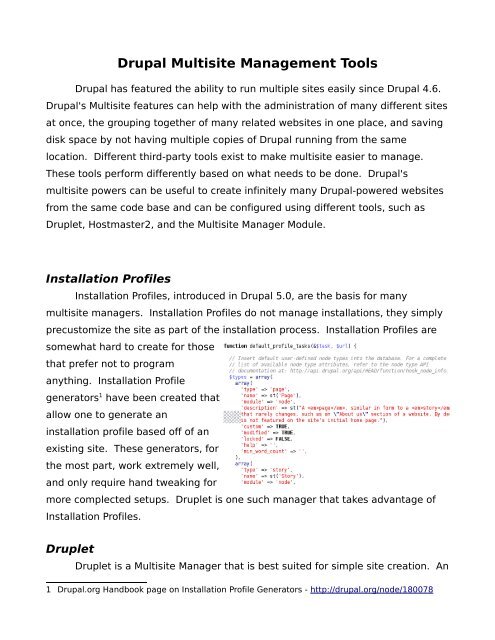Drupal Multisite Management Tools
Drupal Multisite Management Tools
Drupal Multisite Management Tools
You also want an ePaper? Increase the reach of your titles
YUMPU automatically turns print PDFs into web optimized ePapers that Google loves.
<strong>Drupal</strong> <strong>Multisite</strong> <strong>Management</strong> <strong>Tools</strong><br />
<strong>Drupal</strong> has featured the ability to run multiple sites easily since <strong>Drupal</strong> 4.6.<br />
<strong>Drupal</strong>'s <strong>Multisite</strong> features can help with the administration of many different sites<br />
at once, the grouping together of many related websites in one place, and saving<br />
disk space by not having multiple copies of <strong>Drupal</strong> running from the same<br />
location. Different third-party tools exist to make multisite easier to manage.<br />
These tools perform differently based on what needs to be done. <strong>Drupal</strong>'s<br />
multisite powers can be useful to create infinitely many <strong>Drupal</strong>-powered websites<br />
from the same code base and can be configured using different tools, such as<br />
Druplet, Hostmaster2, and the <strong>Multisite</strong> Manager Module.<br />
Installation Profiles<br />
Installation Profiles, introduced in <strong>Drupal</strong> 5.0, are the basis for many<br />
multisite managers. Installation Profiles do not manage installations, they simply<br />
precustomize the site as part of the installation process. Installation Profiles are<br />
somewhat hard to create for those<br />
that prefer not to program<br />
anything. Installation Profile<br />
generators 1 have been created that<br />
allow one to generate an<br />
installation profile based off of an<br />
existing site. These generators, for<br />
the most part, work extremely well,<br />
and only require hand tweaking for<br />
more complected setups. Druplet is one such manager that takes advantage of<br />
Installation Profiles.<br />
Druplet<br />
Druplet is a <strong>Multisite</strong> Manager that is best suited for simple site creation. An<br />
1 <strong>Drupal</strong>.org Handbook page on Installation Profile Generators - http://drupal.org/node/180078
official development release is listed, but no<br />
stable release as of 1/17/2008. Currently, it<br />
is not compatible with <strong>Drupal</strong> 6 2 . It is<br />
relatively easy to setup, as the hardest part<br />
is to create the installation profile that it will<br />
use. The use of Installation Profiles allows it<br />
to be extremely flexible with the creation of<br />
sites, called Druplets. Using these<br />
installation profiles, it creates a new site by<br />
putting a new directory in the /sites<br />
directory. The author of Druplet does<br />
recommend that it not be used in a production environment, as it may allow users<br />
to read the settings.php file from another site. This is a HUGE security risk, and<br />
anyone using this should definitely not use it in a production environment.<br />
However, PHP Input (The root cause of the security hole) can be safely disabled<br />
with Paranoia Module, thus closing that hole. Druplet has two options: Single User<br />
and Multiple User. Single User mode works by creating directories and files in the<br />
sites/* directory. Multiple User mode also adds SFTP users. Druplet seems pretty<br />
stable, and according to Matt Konglin (Maintainer) will see a development release<br />
soon. For more information on Druplet, see http://drupal.org/project/druplet.<br />
Hostmaster2<br />
Hostmaster2 is yet another <strong>Drupal</strong><br />
<strong>Multisite</strong> Manager. It is somewhat more<br />
complected than Druplet, and thus is<br />
somewhat hard to learn. The trade off of this is<br />
that Hostmaster2 is the most powerful <strong>Multisite</strong><br />
Manager of these. Installation of Hostmaster2<br />
is difficult because it requires checkout of the<br />
correct things from a subversion repository<br />
where different parts of the same project are<br />
2 As of 1/5/2008
stored. People who are used to SVN may still find problems navigating the<br />
repository to find the correct modules. Documentation on the Installation Process<br />
and usage also seems to be lacking, but understandable for a project still in early<br />
development. Many different things related to Hostmaster2 are still under heavy<br />
development, and the modules do not always work correctly. However,<br />
Hostmaster2 is a great <strong>Multisite</strong> Manager after all of the initial installation issues<br />
have been dealt with. Like Druplet, it uses Installation Profiles to precustomize a<br />
site as part of the site creation process. For more information on Hostmaster2,<br />
see http://groups.drupal.org/hm2 and https://svn.bryght.com/hostmaster.<br />
<strong>Multisite</strong> Manager Module<br />
The <strong>Multisite</strong> Manager module is also similar to Druplet, but without the<br />
security problems 3 . The current stable release<br />
is not compatible with <strong>Drupal</strong> 6 4 . Using the<br />
<strong>Multisite</strong> Manager module is extremely easy,<br />
as it uses the standard <strong>Drupal</strong> Content<br />
creation mechanism, in this case, Create<br />
content > Site. Installation Profiles allow it to<br />
do further customization to the site while it is<br />
being created. The <strong>Multisite</strong> Manager module<br />
is an easy way to manage multiple sites, but it<br />
is not as powerful as Druplet and Hostmaster2, as it lacks the ability to create<br />
SFTP users and other such features. The <strong>Multisite</strong> Manager module is available at<br />
http://drupal.org/project/multisite_manager.<br />
<strong>Drupal</strong>'s <strong>Multisite</strong> capabilities can help make the running of many different<br />
sites easier using tools such as Druplet, Hostmaster2, and the <strong>Multisite</strong> Manager<br />
module. When these tools work correctly, they can simplify the administration<br />
process substantially. The use of installation profiles allows these managers to<br />
further customize the output site. The <strong>Multisite</strong> Manager tool is easily the best<br />
3 In the default configuration; There is an option that will cause the <strong>Multisite</strong> Manager module to<br />
have the same problems as Druplet for the same reasons.<br />
4 As of 1/10/2008
choice when managing multiple <strong>Drupal</strong>-powered websites, for reasons of stability<br />
and usability.<br />
Ease of<br />
Installation<br />
Ease of Use<br />
Security<br />
<strong>Multisite</strong> Manager<br />
Module<br />
Beautiful<br />
After Installation<br />
profile creation, very<br />
easy<br />
Secure, unless the<br />
option to create<br />
separate databases is<br />
enabled<br />
Druplet Hostmaster2<br />
OK, after the CVS<br />
checkout<br />
After Installation<br />
profile creation,<br />
Beautiful<br />
Major security<br />
risk, unless PHP<br />
code is disabled<br />
with<br />
paranoia.module<br />
Extremely Difficult<br />
Hard to get<br />
working<br />
With provisioning,<br />
pretty secure<br />
Flexibility Very Flexible Very Flexible Very Flexible<br />
Ease of<br />
Upgrade<br />
Not available for<br />
<strong>Drupal</strong> 6<br />
Development Stable development<br />
Not available for<br />
<strong>Drupal</strong> 6<br />
Still in<br />
development, very<br />
stable<br />
Being developed<br />
for <strong>Drupal</strong> 6<br />
Still in<br />
development, not<br />
very stable






